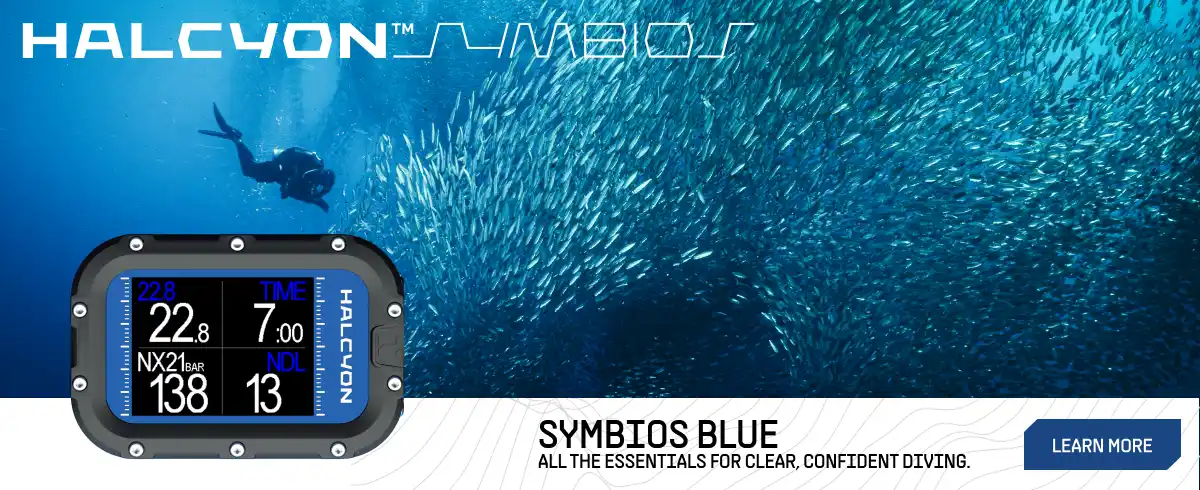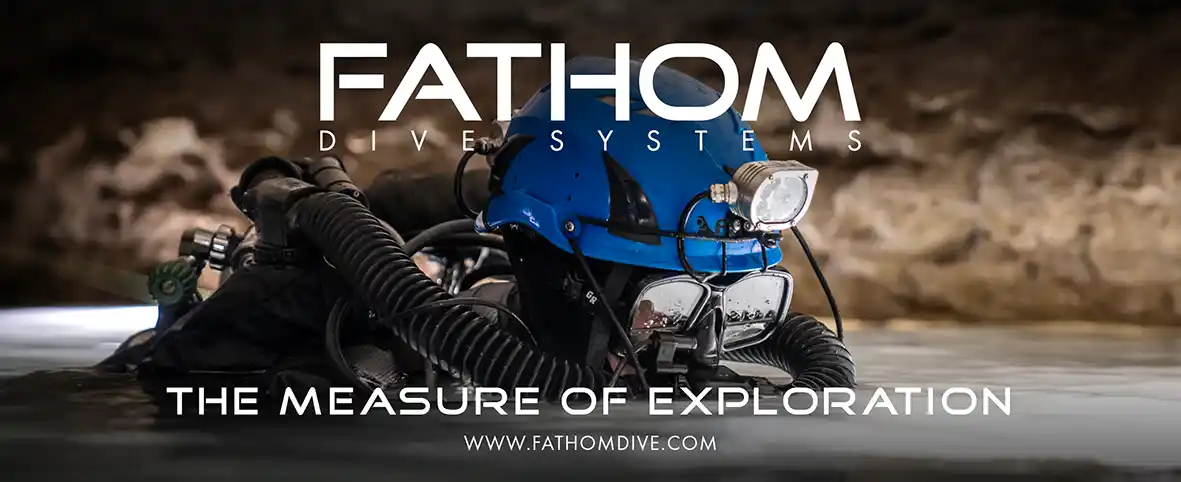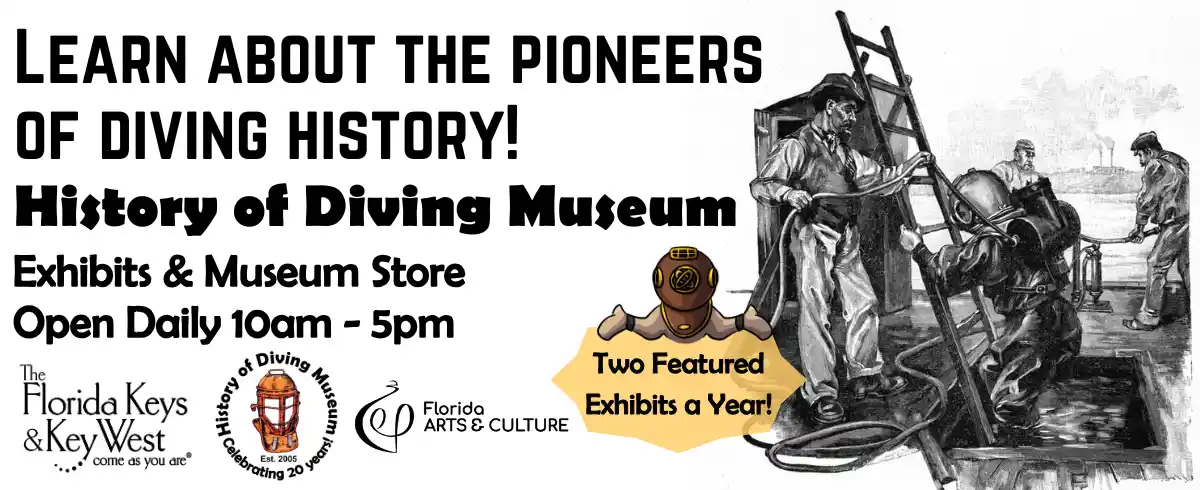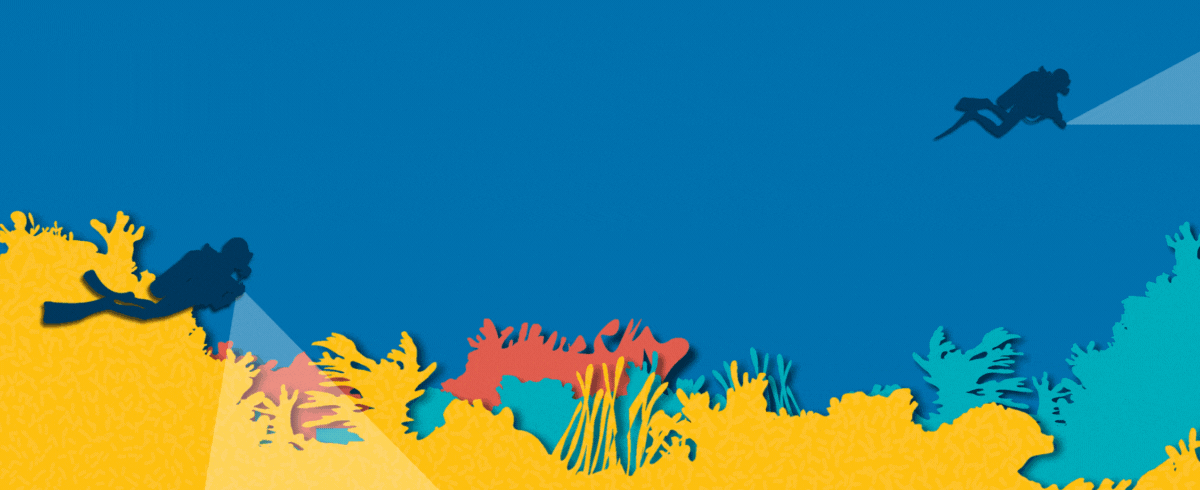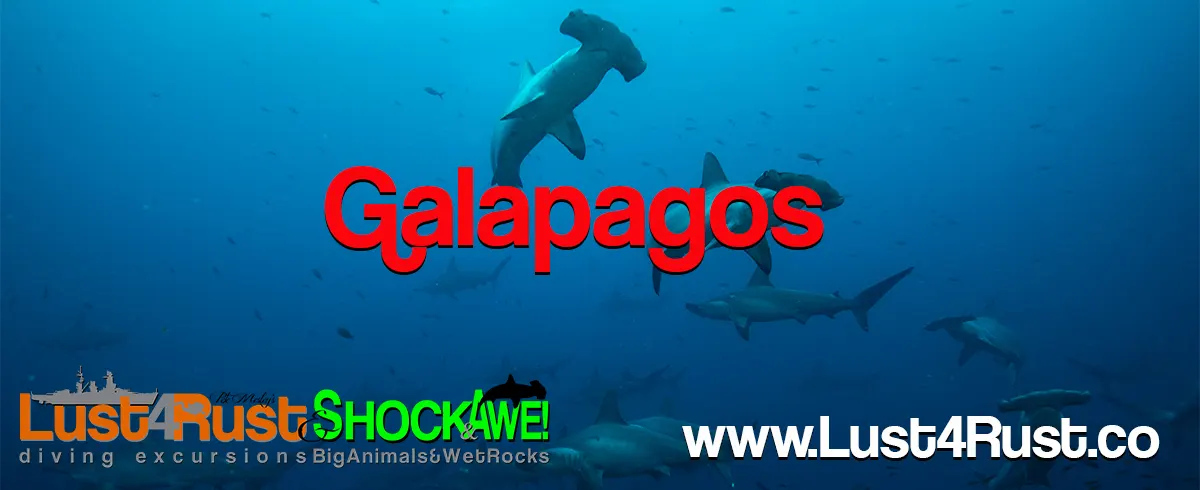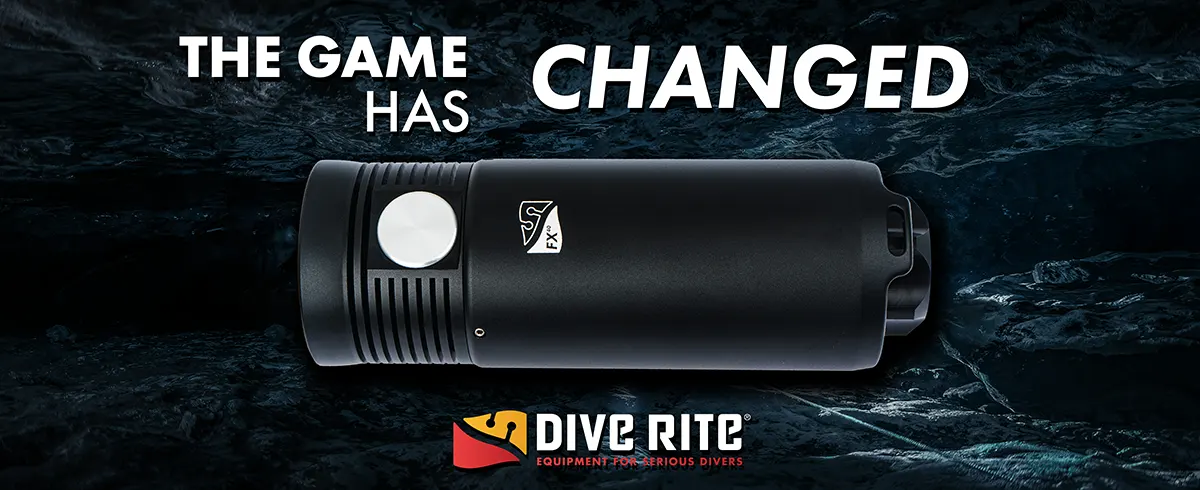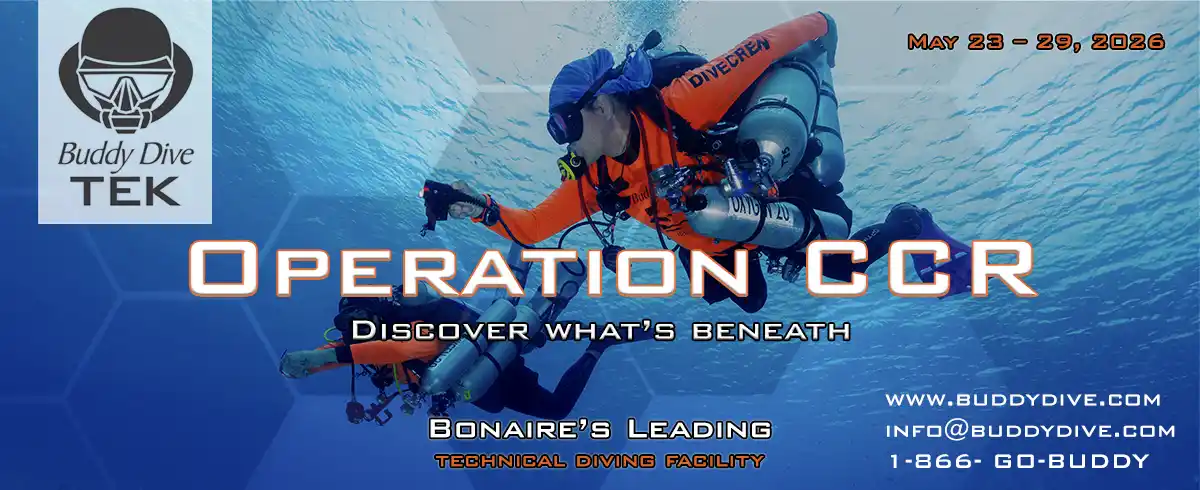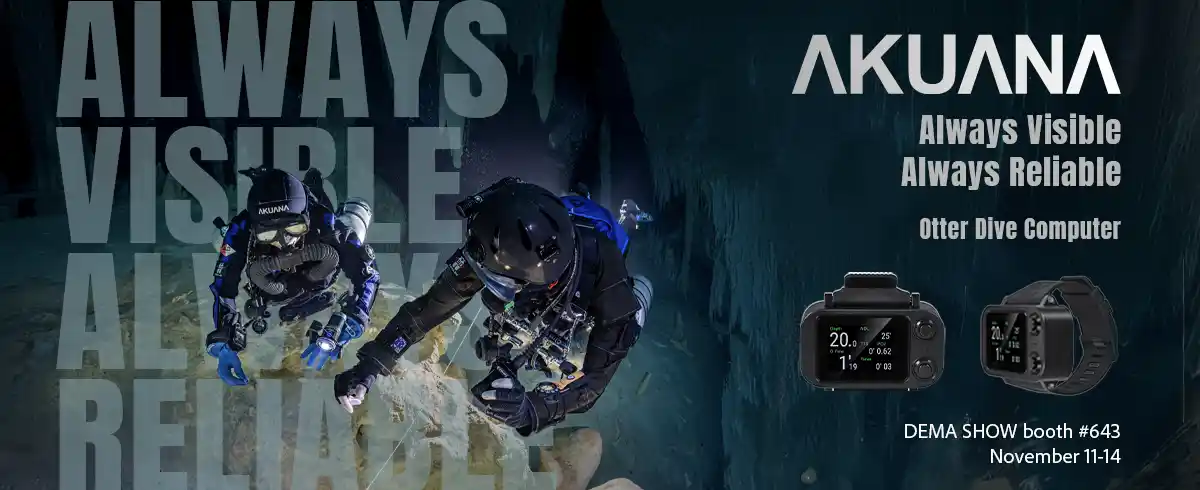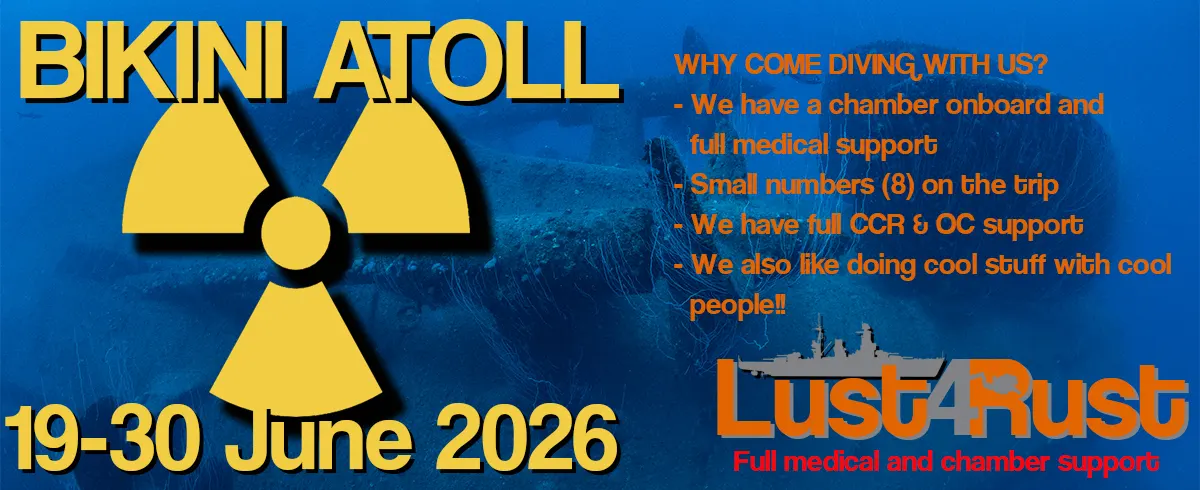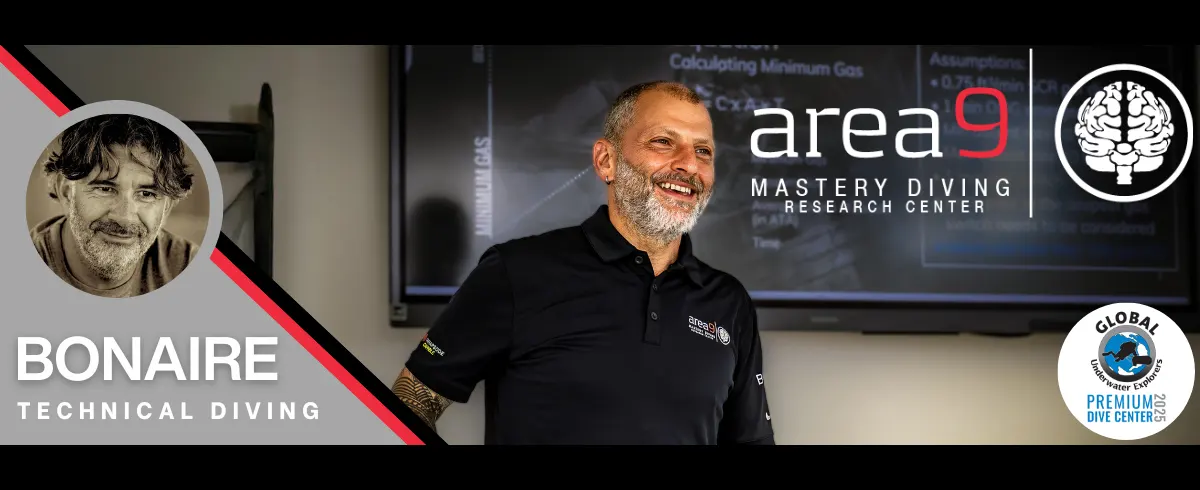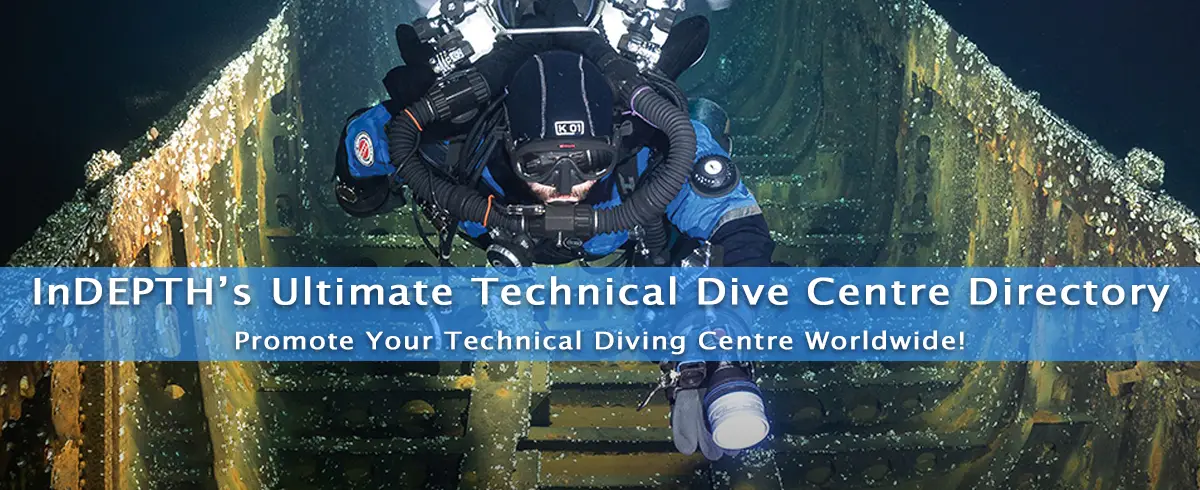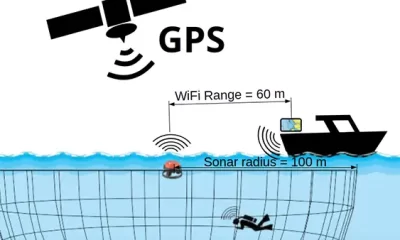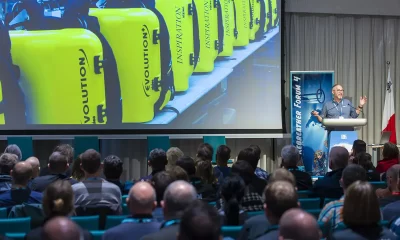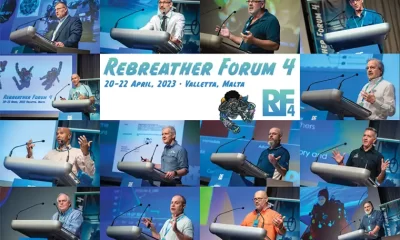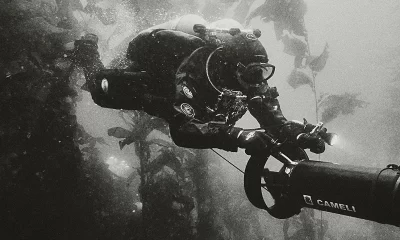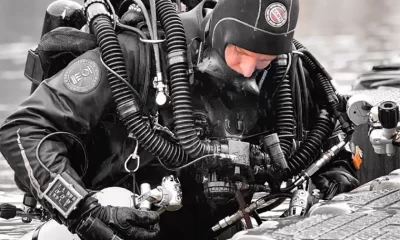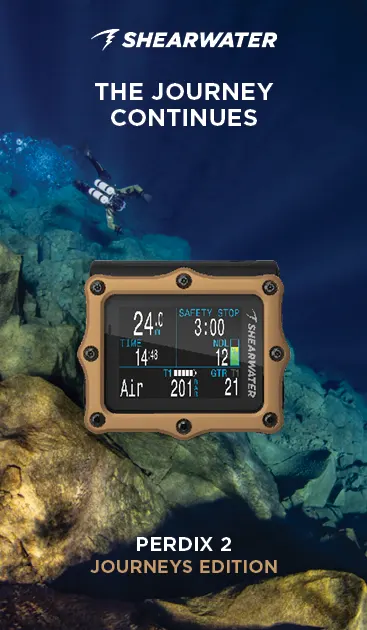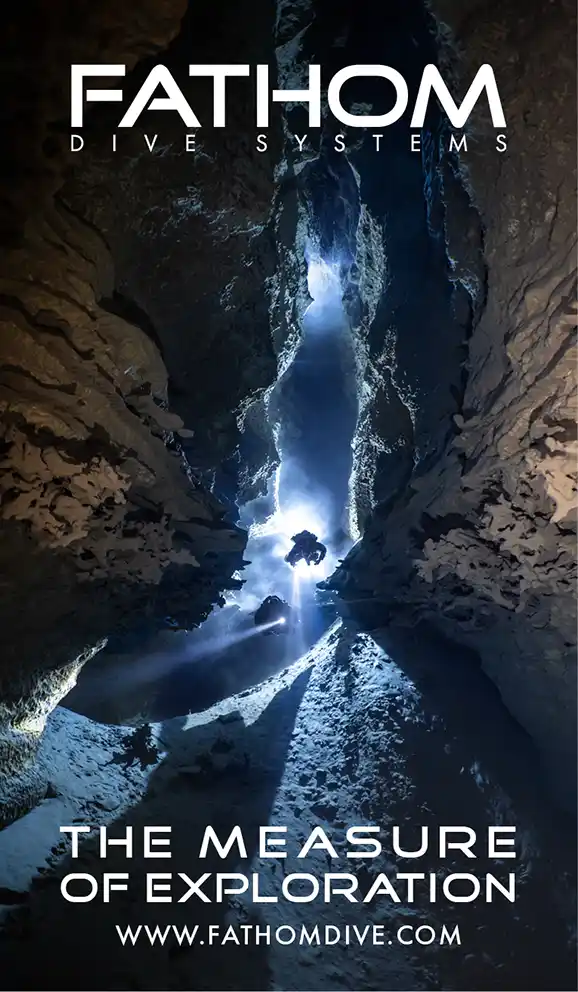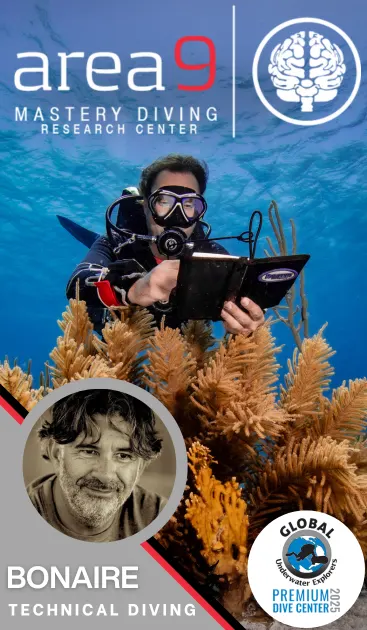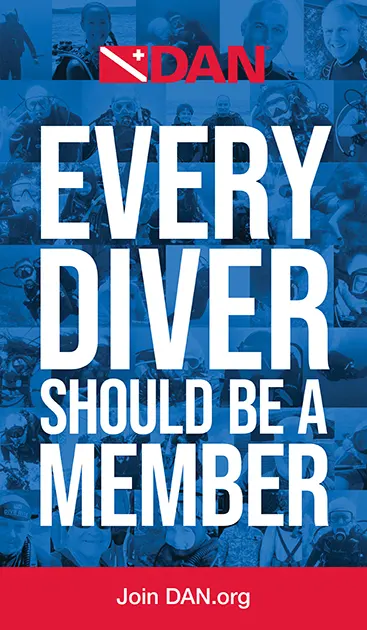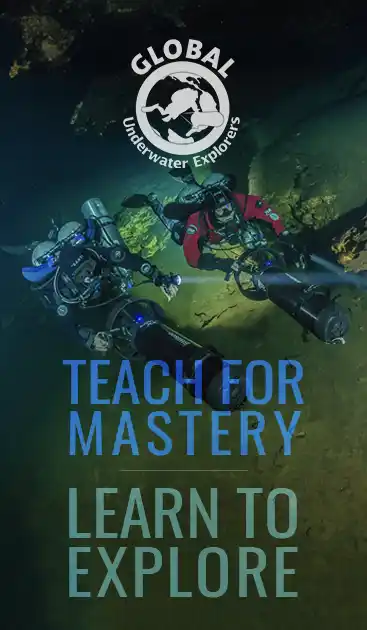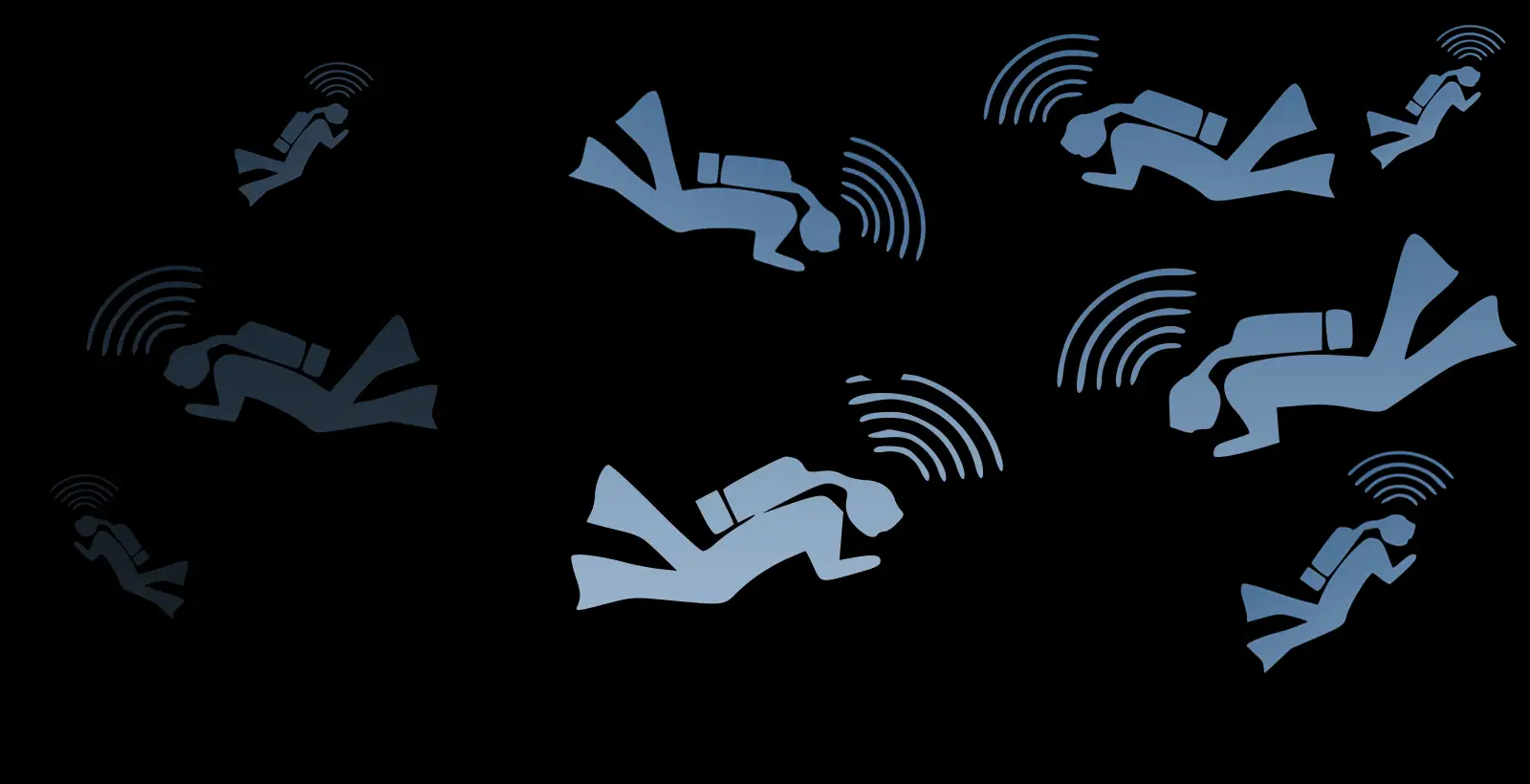
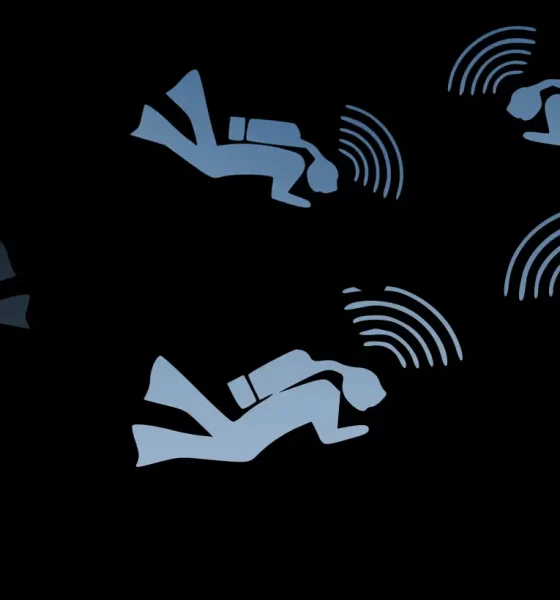
Latest Features
Are We Ready for High Speed UW Wireless Connectivity?
Technologist Gabriel Pineda reviews the latest developments in underwater wireless networking and what it may mean for tech diver navigation, communications and the progression of UW electronics. He then takes us for a dive into tech start-up OceanComm and their mission to bring high-speed wireless connectivity to the undersea space! What could we do with high bandwidth, underwater wireless connectivity? Plenty!
By Gabriel Pineda. Lead image collage by Rico Besserdich.
Back in Oct 2023 I wrote an article about underwater navigation technology. It was meant to explain why electronic navigation technology is not as common underwater as it is topside. It was framed in the context of a snapshot in time. Some things have changed since.
Halcyon paired with Oxygen Scientific and launched the Symbios eCCR which uses optical O2 sensors and wireless handsets. KISS rebreathers followed suit announcing their intention to use optical sensors and wireless handsets. Greg Borodiansky made the Generic Breathing Machine rebreather available, again, contemplating wireless transmission of millivolts directly to wireless integrated computers. Lungfish got CE certification for their Orca v6 rebreather, and is also considering wireless transmitters for their rebreathers. Garmin launched the Descent Mk3 in November 2023. The introduction of a transceiver was of particular interest. This gave the Mk3 the capability to send underwater messages between divers as well as monitor divers while keeping track of their location, depth and distance in relation to each other.
So what does this have to do with the October article on underwater navigation? That article tried to provide an answer as to why, as of 2023, we don’t find underwater “GPS” as commonly as we see topside GPS applications. In the primer article, I wrote a section exemplifying potential paths to scalability and widespread adoption of electronic underwater navigation tech. That said, the article did not properly address what we could expect in the near future in terms of a product roadmap and the progression of underwater electronics.

This current article will try to expand on it. The connection to the Mk3 is that it marks the introduction of an underwater wireless data network aimed at and priced for the sports diving market. The reader may note that the Mk3 does not offer underwater GPS. Consider that underwater wireless data networks can be a big piece of the puzzle for underwater navigation technology. In the previous article we explored how an ultra-short baseline (USBL) underwater network can be paired with a topside GPS to provide the underwater GPS experience.
How difficult do you think it will be for a company like Garmin to add topside GPS functionality to a reinforced version of the Mk3 underwater network? Garmin already leads electronic navigation in aviation, boating, hiking, etc. It stands to reason that expansion in this way into the underwater realm is within their sights. It’s been six years since they made the initial incursion into the sports diving market with the introduction of the Mk1. They are no longer the newcomers making an incursion underwater from the world of topside multisport watches. I’d say they are firmly entrenched in our community now.
Going Beyond – Dive, Navigate, Communicate
The significance and potential of wireless underwater networks goes well beyond just navigation. Let’s frame it within a sports diving context using parallels drawn from a couple decades ago when I was undergoing flight training. There was a phrase that was drilled into our heads to establish the primacy of our actions: Aviate, Navigate, Communicate.
- Fly the airplane and ensure you are keeping it safely in the air
- Get to where you want to go safely
- Talk to people along your way to ensure you are safe, have help readily available if needed, and ensure you are not posing a danger to others
The phrase was meant to guide our actions at all times, but especially during emergencies. Lost your engines? Aviate, Navigate, Communicate.

- Aviate: Put your plane on best glide speed to buy yourself as much time before the inevitable contact with ground. Follow the emergency procedures checklist to help you keep the plane flying.
- Navigate: Head out to the safest landing surface within reach of your glide path
- Communicate: Tell the world about your position, your condition, and your intentions while asking for help.
Avionics continue to evolve over time delivering ever increasing capabilities. Of course, you can successfully make a decompression dive with just a brass and glass depth gauge and an old Casio G-Shock. But it is so much nicer to do deco dives with a robust and capable dive computer. That is why most deco divers today use dive computers. Likewise, you can safely fly an airplane with analog six pack gauges, but flying a modern, digital glass cockpit is a nice improvement.

A good, purposeful progression of underwater electronic tech can be framed under a similar pattern: Dive, Navigate, Communicate. This approach can help companies maintain their focus on things that matter to their customers. Current dive computers do a decent job helping the diver do the <Dive> part of the phrase. You have excellent indicators of depth, time, and how these apply to the decompression algorithm. The <Navigate> part is usually limited to just a compass in dive computers. There’s still a lot of room for improvement. Other than the aforementioned Mk3 network, the <Communicate> is practically non-existent for sport divers beyond visual range. This is a glaring example of the wide technological gap between topside vs underwater applications.
The gap is very noticeable when comparing wireless data networks. So much of our top side tech relies on some form of network, often a wireless one. There are significant physical differences around the transmission of electronic signals through air vs water. These differences impact factors like bandwidth. Bandwidth refers to the capacity at which a network can transmit data. For example, if a client device in a network is using a 802.11b adapter, it cannot accept a data transfer of more than 11Mbps, even if the network itself is capable of faster data transfers.
802.11b was the first WiFi standard going back all the way to the 1990s. These days, if you google this standard you will get a bunch of low cost network adapters. The point being that bandwidths of 11 Mbps or higher in wireless networks have been available topside for a while and are basically ubiquitous.

In contrast, traditional underwater wireless data comms are typically around ~100 bps. Note the lack of an “M” or even a “K” in front of the bandwidth figure. This means that our old, ubiquitous 802.11b network adapter has about 110,000 times more bandwidth than traditional underwater data comms. If you’re old enough, you might remember your old dial-up modem which had a max theoretical bandwidth 56 kbps. Remember how long it took to download a couple of songs from Napster using dial up? Well, 56 kbps is still 560 times more bandwidth than traditional underwater comms seen today.
Now let’s go back to that 1990s-early-2000s world and remember what the world was like when we didn’t have the availability of bandwidth as we have it today. Video calls were bad, low res, and unreliable, if available at all. Blockbuster ruled and Netflix sent you DVDs via snail mail. Music came in CDs or cassette tapes, and if you wanted to carry it with you, you had to have a Walk-Man or a Disc-Man. And the nostalgia-dripping list can go on and on. Bandwidth increase changed the world that we live in. When you factor the significant differences in bandwidth availability between topside and underwater, it is no surprise to see things being so far behind comparatively.
Enter OceanComm
But it is not all a bleak panorama for underwater networks. There are some interesting advancements. I had the privilege to talk with Thomas Riedl, President and Founder of OceanComm. OceanComm aims to bring “high-speed wireless connectivity to the undersea space.” Thomas explained some of the current weaknesses of traditional undersea comms. Not only is the bandwidth low for today’s topside standards, but the range is also pretty low at 1 to 2 km in shallow water and less than 10 km for deep water. Compare that to the range of 35 km for a cell phone tower.

OceanComm works with the Defense Advanced Research Projects Agency (DARPA) and is currently funded by the Office of Naval Research (ONR). There are a number of solutions for wireless underwater data communications. Free-space optical communication can provide a relatively high data rate of, for example, 1 Mbps, but is limited to short distances of up to about 65 ft (20 meters). At distances beyond that, acoustic communication is basically your only option.
OceanComm built another acoustic modem, but their modems offer data rates between 100 and 1000 times higher than previously possible. While traditional acoustic modems are limited to text messaging, OceanComm modems can livestream video. Payload data rates are over 400 kbps. This is a sample of a wirelessly streamed video of an airplane wreck at a depth of 100 m (330 ft):
DAVD + OceanComm?
It is fascinating to consider the potential that OceanComm is bringing to the table. As Thomas was explaining the capabilities of their modems, I started to think how neat it would be to pair the Coda Octopus Diver Augmented Vision Display (DAVD) and untether it. I related DAVD in my conversation with Thomas because DAVD is another neat idea with much potential. However, the limitations on underwater wireless bandwidth keep DAVD tethered with an umbilical if its full capabilities for mixed reality with real time 3d modeling and full video are to be used.




Imagine an autonomous dual rebreather diver (bailout ccr) breathing a deep hydrogen mix, with a DAVD interface on an OceanComm wireless network. Diving as we know it would be so different, perhaps fundamentally so. The US Navy has DAVD, and the Army has IVAS. Multiple mixed or augmented reality devices networked and sharing information in real time will help paint a more complete picture for better informed decisions. But this is only possible with high bandwidth wireless networks. Saab calls this type of networked human-machine collaboration a shared nervous system. It transforms the landscape into an integrated battle environment with each soldier, marine, airman, or sailor being a 2 way data user/collector. OceanComm could help make this happen for underwater environments.
Unique Approach
OceanComm uses a unique approach to underwater networks. About 2 years ago I was testing out an alpha version of Sonardyne’s DiveTrack in the Caribbean. DiveTrack uses a set of acoustic modems and a technique called USBL paired up with a topside GPS receiver to determine a diver’s position underwater. One thing that called my attention was the audible report of the underwater modem going off regularly. It was significant enough for me to be concerned about it just before beginning the dive. I was wondering if it would be bothersome during the dive. Fortunately, once I got about 10-15 minutes underwater I was able to unconsciously blank it out. It took me about 10-15 minutes to realize I was no longer thinking about it because there was no discomfort.
As you increase the range of acoustic based systems the energy of the audible signal also increases. This poses a limit on systems worn by divers because there is a point when the energy of the signal can cause damage to the diver. In my case, the modem I was using was well within healthy limits and within comfortable levels. This allowed me to put the modem on the manifold of the doubles I was using as dilout for the ChO2ptima I was diving.
And yes, that is my 40+ year old set of Mk10s with G250 Graphites. Several of my Mk10/G250 sets came originally from my dad. The perception of my old age is magnified by this ?. I still keep these reg sets around. I find it relaxing to work servicing them. I formed a sentimental attachment to these things and they are my favorite reg models. I hope this answers some of the mysteries the good folks at ScubaBoard were pondering on: https://scubaboard.com/community/threads/old-guys-rule.630824/


But I digress. Sonardyne’s DiveTrack system uses frequencies between 20-28 kHz. This is why it is audible to the human ear. The human ear can detect sounds from roughly 0.02 kHz to 20 kHz. OceanComm modems operate at substantially higher frequencies and across a wider band, between 50-200 kHz.
Higher frequency waves attenuate more quickly and generally have less range. However, this shortcoming can be overcome if the sound is focused, similar to how a laser focuses light. OceanComm modems still offer omni-directional coverage and do not require manual alignment. Their modems can concentrate the emitted signal into a narrow beam and steer that beam toward another modem. Signal emission in unwanted directions is kept to a minimum. This approach not only increases range, it also minimizes the strength of echos, improving both the reliability and speed of the link.
Applications
That said, OceanComm has not had much interaction with sport divers… yet. They have been more focused on commercial and military applications. Thomas mentioned their work with ROVs and UUVs.


About a year ago while working on the Glass Sponge Research Initiative, we had the opportunity to use an ROV. This particular ROV has an umbilical reel with a modern 3mm thick cable. This ROV operates with 1300 ft of cable in a floor supported reel. Managing the umbilical was an operating concern. Things would have been much easier if we were operating a reliably untethered version.
Are There any OceanComm Applications for Sport Divers?
The short answer is not yet. But the potential is significant. We regularly use Garmin’s Navionics app to plan some of our dives. I have an entry level Garmin Striker fish finder with GPS in my small aluminum boat. It has a Quickdraw Contours feature that updates the contour maps with information it gathers from its depth sounding capabilities. These bottom contour maps can be shared with the community if your Garmin fish finder has WiFi capabilities that allows it to connect to the ActiveCaptain app.


The Navionics website claims that they “constantly enhance our charts with new and amended content from official hydrographic sources, public and private surveys, and millions of contributions from boaters.” The website says it makes up to 5,000 updates every day affecting all chart layers. This is the power of networks. Data gathered by people boating around can and probably does enhance the dives we plan when we use Navionics. Even if a certain capability was not initially meant for sport divers, the power of networks can make it easily applicable to our purposes.
Imagine that in addition to using our cell phones/laptops with Navionics to plan our dive before immersion, we now prepare 3D models to send to our DAVD augmented reality masks so that we have the 3D overlay models guiding us to our exploration target even in near zero visibility. The Garmin data gathered on a daily basis by millions of boaters is 3D data that could, in theory, be used for 3D augmented reality overlays. And all of this is empowered by topside and underwater wireless networks. Furthermore, divers using networked dive computers could be contributing to this wealth of data, just like boaters do.

Sports Diving, Why Can’t We Have Nice Things Too?
We’ve mentioned this before, transferring electronic signals through water is physically different than air. It is a different world where we are the aliens. Our native topside world has so much tech that we take for granted and yet is not used underwater.
For example, topside pulse oximetry equipment is non-invasive, it has a low acquisition and operation cost and it literally measures in real time, the percentage of hemoglobin molecules that are oxygenated in our blood stream. You would think this type of information is of vital interest to divers as it would answer in real time if the diver is breathing a gas mixture that allows enough oxygen to bind with hemoglobin and sustain life. Topside pulse oximeters have been around for a while, yet we don’t have them commercially or readily available to sports divers. Dr. Rachel Lance is doing some fascinating work around this: “The Dewey Monitor: Pulse Oximetry can Warn of Hypoxia in an Immersed Rebreather Diver in Multiple Scenarios
Ashley Stewart wrote about a similar situation around measuring CO2 during a dive in the same way that anesthesiologists do in a medical setting: Will End-tidal CO2 Monitoring Become a Reality in Diving?
We can keep on digging and we will find no shortage of examples of tech that is so common topside that we take it for granted. And yet this common tech hasn’t made its way to become available to sport divers.
Even more mundane tasks like fighting boredom pose unique challenges when done underwater. What do you do during a long, bluewater deco session? Yes, while underwater you can:
- Read books, mags
- Hear music, podcasts and ebooks
- Watch movies
- Play video games
All of these activities pale in comparison to the topside experience alternatives. Look back at those four bullet point list items. These days, those four topside activities are enhanced by and rely on data networks. Yes, there was a point in time, not so long ago, that these leisure activities were largely, even totally, independent of data networks. These days they are all largely dependent on data networks.
Adoption of underwater tech advancements will be boosted by the deployment of underwater wireless data networks like the ones that OceanComm is working on. So allow me to reiterate, while there are no direct OceanComm applications for sport divers yet, the potential is immense.
The adoption of tech new to the underwater realm may be faster than how it happened topside. There could be the ability to leap frog over and bypass some stages. For example, many regions that had little to no wired landline telephone networks, all of a sudden had access to cellular networks and the internet. These regions leapfrogged over and bypassed a bunch of telephone poles carrying telephone cables. They never got to experience the joys of a 56 kbps dialup modem.
Get Back to the Boat!
This article wouldn’t feel right without a proper dive story. So here it goes.
Earlier I mentioned the audible report coming from Sonardyne’s DiveTrack system. We were working on and testing an alpha version of DiveTrack with members of a government institution. Regulations wouldn’t allow the institution’s team to go beyond certain depth limits or engage in a certain level of deco obligation. At least not with the gear and support levels that we had at the time. So my colleague and I did some of the deeper dives on a rEvo rebreather and a ChO2ptima.
On one of the dives I had to go solo because my colleague was to remain in the boat working with the topside units. Prior to the dive we agreed on what data messages and functionalities we were going to test. So we crossed a sea channel in the dive boat and reached a wall dive site on an islet in front of the main island.
It was a beautiful day, calm oceans and sunny skies. I went down and started to execute the dive. I was getting the messages that we agreed on and everything seemed to be going smoothly. Then I got a wireless message from the boat to abort the dive and get back to the boat giving me a distance and bearing to the boat. This abort message was not one that we had planned to use during this dive. I concluded that since it wasn’t part of the features we were going to test, it had to be a real message and, for some reason, topside wanted me back at the boat.
So I followed instructions cutting my dive much shorter than originally planned. I only had a modest 11 minutes of deco to do. During these dives, as we were finishing our deco, we would see the government dive team doing their tests. The divers from the government institution were also testing other equipment, including an ROV. This time, as I got to the boat, I saw no divers in the water. My only other companion in the water was the ROV. Interestingly, I started wondering why. I also noted that the dive boat was getting pretty close to the rocks on shore, and again I wondered why.

I am doing my last deco stop right under the boat, between 15 and 20 fsw, (4.5-6 msw)because there was some wave action making a 3m/10 ft stop less comfortable. Then I see the ROV coming to me. The thing is staring at me and I know it is providing a live video feed. I signaled to it that I still have 9 minutes of deco. I interpreted that the topside team received and understood my hand signals since there was no prompting me to do anything differently.
I finished my deco and ascended. Once at the surface I see the sky is dark and the wind is strong. This wind is pushing the dive boat to the rocks and a squall is not far away and heading to us.
The alpha version of the DiveTrack underwater data network functioned beautifully to address a real life situation. The topside crew knew my depth, distance/coordinates from the boat and direction at all times. They sent me a real wireless message and received my wireless acknowledgement and message of compliance with their instruction. Underwater data comms rock. Solo dives are no longer so solo.
Data networking may not be a glamorous term, but it brings it altogether making our modern world possible. The advancements that we’ve experienced top side will eventually percolate into underwater applications.
Data networking may not be a glamorous term, but it brings it altogether making our modern world possible. The advancements that we’ve experienced top side will eventually percolate into underwater applications.
DIVE DEEPER
InDEPTH: A Primer on Underwater Navigation Technology by Gabriel Pineda
InDEPTH: Introducing the DPX ORION: Underwater Tablet Platform for Divers

Diving has been in Gabriel’s family for four generations. Gabriel started diving in 1990 with his father. His father started diving circa 1964 with his grandfather. These days Gabriel’s 14-year-old son is his most frequent dive buddy. As a certified advanced trimix diver, Gabriel enjoys diving rEvo and ChO2ptima rebreathers. Gabriel started working for Shearwater Research in August 2017. In September 2018, and again in September 2019, Shearwater made the ranks of Canada’s Growth 500 list – Canada’s fastest growing companies. By the end of 2018, Gabriel was responsible for all customer facing activities in Shearwater, Sales, Marketing, Customer Service, Service Centres, and Business Development leading a team of highly skilled, consummate professionals. Gabriel stopped working for Shearwater in November 2022. During his tenure, Shearwater became the computer of choice for many divers, officially including the Canadian and US Navies among others. Gabriel Pineda has a BSc in Chemistry, a BBA in International Business and an MBA from Harding University.


